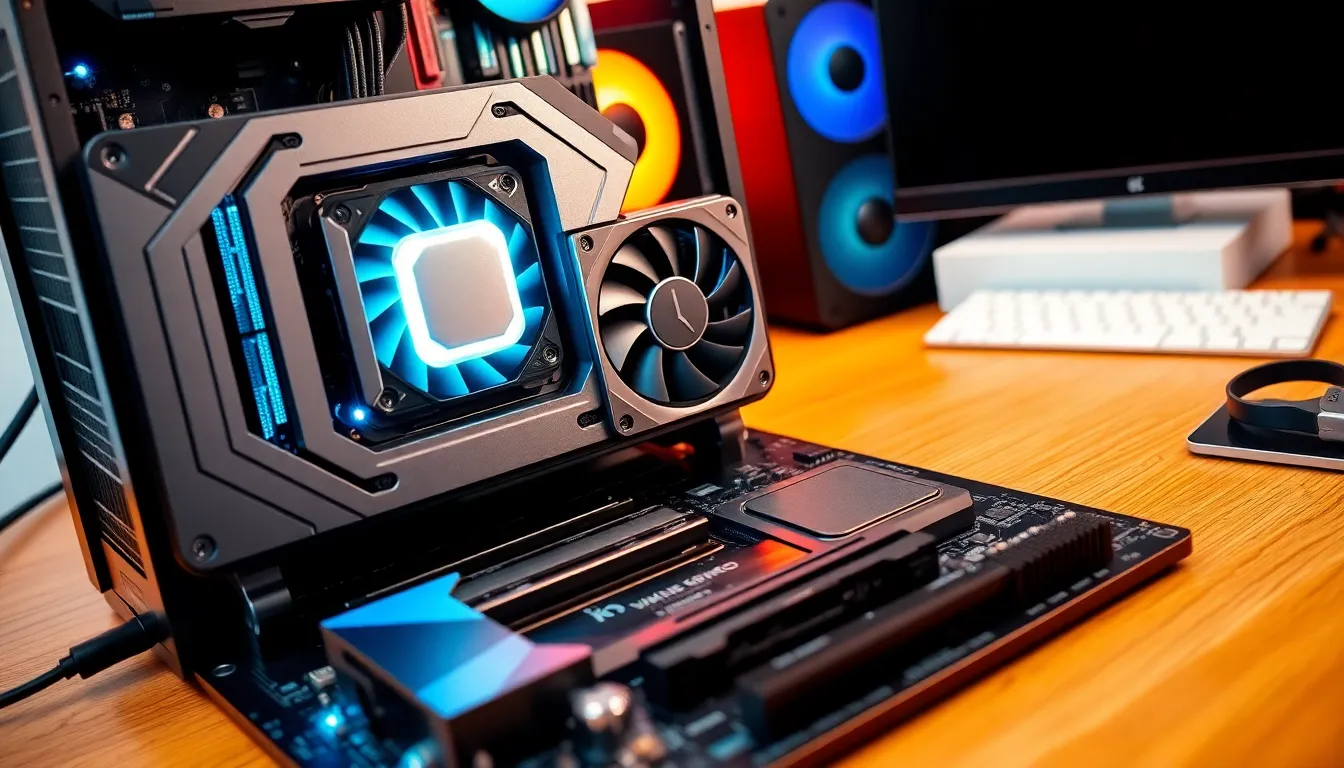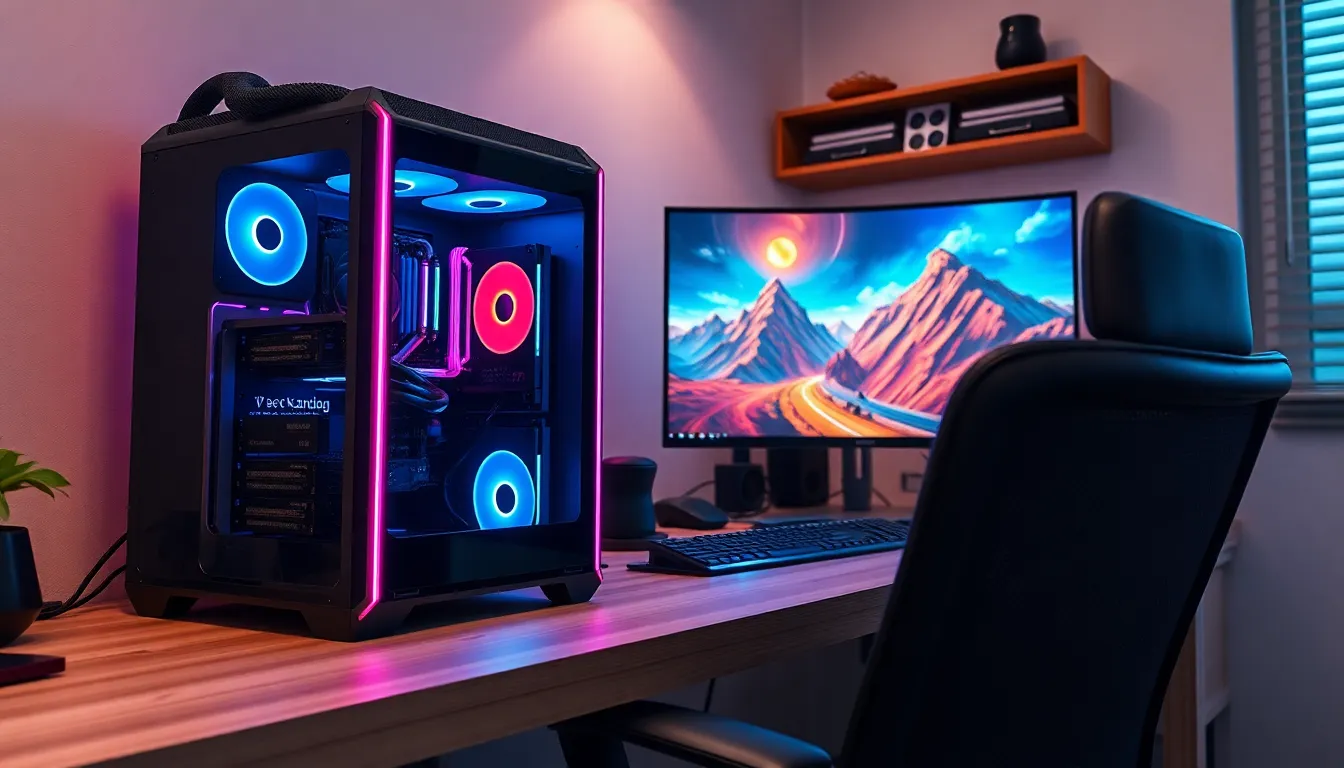In a world where laptops steal the spotlight, desktop hardware remains the unsung hero of computing. Picture this: a powerful machine sitting proudly on a desk, ready to tackle anything from graphic design to gaming marathons. It’s like the trusty sidekick that never lets you down, offering performance and upgradability that laptops can only dream of.
Table of Contents
ToggleOverview of Desktop Hardware
Desktop hardware consists of vital components that work together to deliver exceptional performance. Central processing units (CPUs) serve as the brains of the computer, executing instructions and performing calculations. Graphics processing units (GPUs) enhance visual output, making desktops ideal for gaming and graphic design tasks.
Motherboards play a crucial role, connecting all components and facilitating communication between them. Storage options like hard disk drives (HDDs) and solid-state drives (SSDs) provide essential data storage, influencing load times and overall system responsiveness.
Memory, or RAM, allows for multitasking, enabling users to run multiple applications simultaneously without lag. Power supplies convert electrical power from outlet sources into usable energy for the system.
Cooling systems, including fans and liquid cooling solutions, manage heat production, ensuring optimal performance during intensive tasks. Case designs impact airflow and provide aesthetic appeal, with options ranging from compact to full-tower models.
Peripheral devices, such as monitors, keyboards, and mice, enhance user interaction, making the desktop experience more efficient and enjoyable.
Desktops offer significant advantages over laptops, especially in terms of upgradability. Users can easily replace or enhance individual components based on their evolving needs. The capacity for expansion fosters longevity, providing a future-proof option for tech enthusiasts.
Advancements in desktop technology continually improve performance metrics, solidifying desktops’ place in serious computing environments. As workloads increase, investing in robust desktop hardware becomes a strategic decision for professionals across various industries.
Key Components of Desktop Hardware

Desktop hardware consists of several key components that work together to deliver powerful performance for various tasks. Understanding these components helps users make informed choices when configuring their systems.
Central Processing Unit (CPU)
The central processing unit acts as the brain of the computer, executing instructions and performing calculations. Performance ratings, such as clock speed measured in gigahertz (GHz), indicate the processing power of a CPU. Multi-core processors, which contain more than one core, enable better multitasking and faster execution of parallel tasks. Users often select CPUs based on their specific computing needs, ranging from basic tasks to demanding applications like gaming and video editing.
Graphics Processing Unit (GPU)
Graphics processing units handle rendering images, videos, and animations, significantly enhancing visual output. Standalone GPUs are often preferred for tasks that require high graphical fidelity, such as gaming or graphic design. Depending on the user’s needs, GPU specifications include memory bandwidth and clock speeds. Many modern GPUs support advanced technologies like real-time ray tracing, providing lifelike visuals in supported applications. Choosing the right GPU directly impacts gaming experience and professional graphics work.
Motherboard
The motherboard serves as the foundation of the desktop, connecting all components and allowing communication between them. Compatibility with the CPU, RAM, and other components is crucial when selecting a motherboard. Features like expansion slots, connectivity options, and onboard audio can significantly enhance a system’s functionality. Quality motherboards improve stability and overclocking capabilities, making them essential for performance-oriented builds. Users consider various form factors, such as ATX or Micro-ATX, based on their specific case and design preferences.
Storage Solutions
Storage solutions encompass hard disk drives (HDDs) and solid-state drives (SSDs), each offering unique benefits. HDDs provide large capacities at a lower cost, suitable for users needing ample storage space. In contrast, SSDs deliver faster read and write speeds, significantly improving system responsiveness and loading times. Many setups utilize a combination of both to balance performance and storage capacity. Choosing the right storage solution depends on individual requirements, budget, and performance expectations.
Memory (RAM)
Random Access Memory plays a vital role in a system’s performance by providing temporary storage for active processes. More RAM enables smoother multitasking and improved performance in memory-intensive applications. Typical configurations range from 8GB to 32GB, depending on the user’s needs. Dual-channel and quad-channel configurations can enhance memory bandwidth, improving overall performance. Selecting adequate RAM ensures optimal operation and better user experiences during demanding tasks.
Types of Desktop Hardware
Desktop hardware comes in various forms, each catering to different user needs and performance requirements.
Gaming Desktops
Gaming desktops prioritize high performance and immersive experiences. Featured components include powerful graphics processing units (GPUs) specifically designed for rendering complex visuals. Multi-core central processing units (CPUs) enhance gaming efficiency and reduce lag. Liquid cooling solutions maintain optimal temperatures during intense gameplay. Customizable RGB lighting and robust cases enhance aesthetic appeal, allowing gamers to personalize their setups. Easily upgradeable parts ensure longevity, adapting to the latest gaming requirements. For serious gamers, these desktops provide unparalleled experiences.
Workstation Desktops
Workstation desktops support demanding tasks in professional environments. Equipped with multi-core CPUs, these machines excel in tasks like video editing, 3D rendering, and software development. High-capacity RAM configurations facilitate multiple applications running concurrently without slowdown. Additionally, advanced graphics cards improve rendering quality, making them ideal for design professionals. High-storage capacity options, including SSDs, allow for quick access to large project files. These desktops are built for reliability, offering stability during long work hours and enhancing productivity across various industries.
All-in-One Desktops
All-in-one desktops blend performance and convenience in a compact design. Integrating the monitor and computer components, these systems save space while maintaining functionality. Energy-efficient CPUs and integrated graphics cater to everyday tasks, such as web browsing and office work. Touchscreen features are available in many models, enhancing user interaction and accessibility. With fewer cables to manage, they create a clean workspace. Ideal for home offices and small businesses, these desktops facilitate an efficient computing environment without sacrificing style.
Trends in Desktop Hardware
Developments in desktop hardware continue to shape the technology landscape, combining efficiency with performance for diverse user needs.
Emerging Technologies
Innovations in desktop hardware now focus on integration and efficiency. Solid state drives (SSDs) remain popular for their speed, contributing to faster boot times and application loading. Graphics processing units (GPUs) incorporate advanced ray tracing capabilities, enhancing graphics quality in gaming and design applications. Modular components gain traction, allowing users to customize systems easily and upgrade as required. Advancements in cooling technologies, such as liquid cooling systems, improve thermal management. Energy efficiency also rises, with many manufacturers designing components that consume less power while delivering optimal performance. These emerging technologies enhance user experiences and ultimately redefine desktop performance standards.
Future Developments
Future trends point towards even greater synergy between hardware and software. Artificial intelligence (AI) integration across hardware promises smarter performance optimization and predictive capabilities. These advancements make desktops more responsive to user behaviors and needs. Workstation systems are likely to evolve, featuring increased processing power tailored to handle advanced applications like virtual reality and machine learning. Miniaturization of components may also trend, creating smaller, more compact desktop units without sacrificing performance. Enhanced connectivity options, such as Thunderbolt 4, facilitate faster data transfer and peripheral integration. As these developments unfold, desktops will continue to adapt, meeting the demands of evolving user requirements in various sectors.
Desktop hardware remains a powerful choice for users seeking reliability and performance. Its ability to handle demanding tasks makes it a preferred option for professionals in various fields. With components designed for upgradability and customization desktops not only meet current needs but also adapt to future demands.
As technology continues to evolve desktops will incorporate cutting-edge innovations that enhance efficiency and performance. This adaptability ensures that desktops will maintain their relevance in an increasingly mobile world. Investing in desktop hardware is a strategic decision that promises longevity and exceptional capabilities for serious computing tasks.

